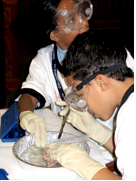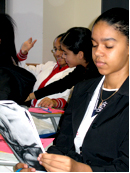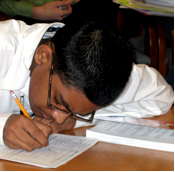
Bringing up scientists:
Nervous and excited at their first dissection ever, they giggle at how they look in their latex gloves and goggles. But they wear their new T-shirts with pride, because they show they belong to the Lang Youth Medical Program, a six-year science enrichment and internship program at New York-Presbyterian Hospital and Columbia University Medical Center.
Started in 2003, the program inspires and supports young people of color—all from the Washington Heights neighborhood surrounding the hospital—to realize their college and career aspirations, particularly in the sciences.
Serious inquiry, way cool
Led by Columbia University pre-med and medical students, the Saturday sessions are serious work, rigorous as any elite college preparatory programs.
His young students describe the similarities between a sheep's brain and their own ("the brain stem," "the cerebellum," "divided into lobes") and then they point out the differences.
"It's a lot smaller!" says Kafela, 12.
"And the brain stem is not at the bottom like in a human brain," says Ryan.
"Anyone know why?" Peter prods.
"Sheep walk on four legs, the posture is different, so the brain has to be located differently to fit the posture," volunteers Deisy.
The exchange turns more technical. Where is the parietal lobe in relation to the occipital? What do we call the lower extension of the brain? What does the prefrontal cortex do?
Afterward, wielding small scalpels like seasoned lab technicians, the young students launch into their dissection. With no sign of squeamishness they slice and probe, investigating as much of the brain as they can see and recording it in drawings and words.
"This is way cool," exclaims Kafela. "I can't believe I'm doing this!"
Scholars with a purpose
Nothing short of a flat-out crash program in hard science will turn these young students' dreams of medical careers into real possibilities, says Erin Roy, the initiative's founder and director. Just as important to her, she emphasize, the initiative nurtures in its participants a new identity as strivers ready to succeed.
Black and Hispanic students are the most likely to drop out of high school and the least likely to pursue advanced degrees, especially in the sciences. They represent less than 3 percent of doctorate degrees in science and engineering. The number of underrepresented minority applicants to U.S. medical schools is now decreasing, from 5,157 in 1996 to 4,091 in 2001.
Few educators regard minority students in under-resourced urban schools as budding scientists worthy of cultivation, Roy contends. To make it worse, science teachers in many such schools lack training and certification; they may not have even taken science courses since high school.
Roy and her teaching staff set the new bar high. Their young pupils, called Lang Scholars, spend six intensive hours every Saturday at New York-Presbyterian, mixing challenging reading with hands-on lessons and lectures by professors and physicians. Once a month, they meet over lunch with Columbia University medical students who act as their mentors.
Be here
Let go of negatives
Be proactive
Be open to outcomes
Be safe
Care for self and others
Speak the truth
The young Lang Scholars have hammered out a code of behavior to which they pledge commitment—their own version of the "First, do no harm" oath that medical students take at the traditional "white coat ceremony." To each Lang Scholar who takes that vow, the president of New York-Presbyterian awards a white coat with their name on it.
What makes us sick
On this Saturday, while the seventh graders explore sheep brains, eighth graders have been looking into the Spanish flu epidemic of 1918, part of a yearlong inquiry into the question, "How do we get sick?"
"The victim's lungs were purple and filled with blood," answers Jose, 13. "The patients drowned in their own body fluids."
"Researchers think it was caused by a strain of avian virus similar to today's H5 bird flu," a boy near the back of the room offers, as the teacher pushes the class further. "It comes from wild birds, geese, ducks, and other fowl, especially that live near water." The group discussion deepens, with students talking of genetic drift and how a virus can leap from pig to man.
Later, in their "literature circles," small groups analyze a text suggesting that emotions, not just bacteria or viruses, can make people ill. The mind-body connection, says Emilia, "means that to be fully healthy, you have to be mentally fit too." Migdalia adds, "It means that healing can come from non-medical treatments, from things other than drugs, such as meditation." Emilia: "It means loneliness can cause sickness." Migdalia: "No way!" Emilia: "Yes it can, sweetie!"
At the other end of the classroom, a group makes a list of new words in the text, like "streptococcal" and "pathogenesis." A third cluster asks questions about the scientific evidence for homeopathic medicine.
A shot in the arm
Steadily, the Lang Youth Medical Program has won the hearts and minds of its participants, young and adult. The program boasts a 95 percent student attendance rate for both the Saturday and summer components. Over 75 hospital and university faculty members have volunteered workshops and lectures or hosted Lang Scholars in their clinics. "These children are a shot in the arm to this institution," says pediatric neurosurgeon Saadi Ghatan. "They inspire me to be a better teacher and mentor."
The program's teaching staff of Columbia University undergraduates and medical students—many from backgrounds like the students'—is hooked, too. Peter, the third-year dentistry student who led the sheep brain dissection, volunteered his services before he learned he would receive compensation. The chance to give back "was pay enough," says Peter.
Marcel Green, a third-year medical student who mentors a boys group, speaks of his excitement when his male students rush to show him their report cards. "It's fulfilling whenever I get an indication that the boys see me as a model of academic success, similar enough to themselves that they can follow."
Ninth-grader Diogenes admits that he used to spend a lot of time in the school principal's office, but this year hasn't been there once. "My teachers notice I've changed," he says. "You've gotten serious, they tell me." His aspirations have changed, too: "Before, I wanted to be a baseball player. I still do, I guess, but if that doesn't work out, I want to be an engineer."
These young students are keenly aware of the toll illness takes among the poor, in their own neighborhood and worldwide. Several talk of using science to make a difference.
"I hope to know more than my science teachers by the end of the program," one Lang Scholar writes in his journal, "to know so much that I find the cure for AIDS and cancers. We are special people that are going to be not just any doctors, but doctors that are going to make a difference in the world."
Even if these Washington Heights youngsters don't choose to become doctors and scientists, they are receiving one of the best immunizations possible: a sense of their own power.
Download (PDF) an in-depth program overview and the junior medical school curriculum.
Listen (MP3) to a PSA about bicycle safety.
Listen (MP3) to a PSA about healthy school lunches.
Read the West Side Scholars' Invictus |
 Peter Trinh, a third-year dentistry student at Columbia Medical School, balances a model of a sheep's brain in his hands as he grills the class on its prior reading assignment.
Peter Trinh, a third-year dentistry student at Columbia Medical School, balances a model of a sheep's brain in his hands as he grills the class on its prior reading assignment.  "What were the symptoms of the Spanish flu?" asks Rosa Estevez, a Columbia University undergraduate student who is leading the day's discussion. "What did doctors find when they did an autopsy afterwards?"
"What were the symptoms of the Spanish flu?" asks Rosa Estevez, a Columbia University undergraduate student who is leading the day's discussion. "What did doctors find when they did an autopsy afterwards?" Along with their precocious knowledge of anterior lobes and pathogens, the program's young scholars are also building confidence. "I have a better perspective on what it means to be determined, college bound, curious, and attentive," observes Stella, an eighth grader.
Along with their precocious knowledge of anterior lobes and pathogens, the program's young scholars are also building confidence. "I have a better perspective on what it means to be determined, college bound, curious, and attentive," observes Stella, an eighth grader.